Sands of Time Music
4930 Saint Elmo Ave. Bethesda MD 20814
Tel: (301) 654-2224 Fax: (301) 656-1658
HOME
| Henkesh home |
| Sayed |
| Khamis |
| Reda |
| Karim |
| Symphony Studio |

| Contact Yasmin |
Awlad Aboul al-Gheit
Awlad Abou al -Gheit is one of Egypt's most well-known Zar groups. The leader, has been a practising Zar musician for over
forty years. The group is made up of 4 men and 4 women, all dedicated to this traditional art of healing the sick
through music and dance.
 The Women
The Women
Lead singer
Haga Karima Shabaan
Tabla, chorus
Haga Karima Mohammed
Duff, chorus
Fatima Farag
Duff, chorus
Leyla Fares
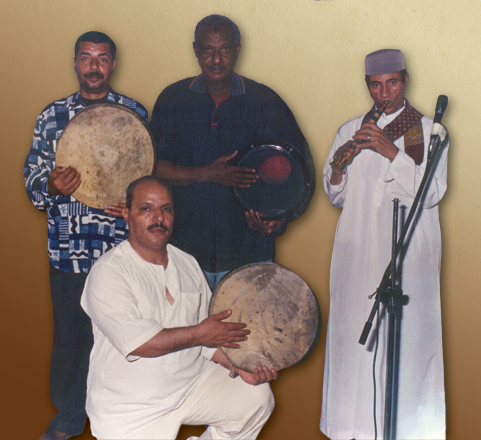
The Men
Nassar (kneeling)
Reda
Hussein
Ibrahim
AN INTERVIEW WITH NASSAR ABDULLA
LEADER OF AWLAD ABOU AL GHEIT
The releaseof this Zar album took me over a year because of the difficulty I had finding information about the ceremony and cult. Even then, my research uncovered little information about the Zar from the people who actually perform it in Egypt. Gerda Sengers, in her wonderful book Women and Demons: Cultic Healing in Islamic Egypt, obtained several interviews with a zar sheikha (leader), but I wanted to know what the musicians thought, what their perspective was on the spirit manifestations they witnessed.
Eventually I badgered the album’s co-producer, Sayed Henkesh, with so many questions for the Zar group that he went to the leader’s home and interviewed him on video for me.
The tape was such a valuable insight into their world that I wanted to share it verbatim with the Middle Eastern dance community. What follows then is an English translation of the video transcript.
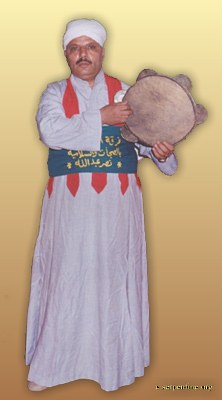 Nasser Mohammed Abdallah |
Nasser Mohammed Abdallah: In the Name of Allah, the Compassionate, the Merciful. My name is Nasser Abdallah, head of the Awlad Abou al-Gheit band. First of all, the ZAR is real. It’s not a myth. I’ve been working in this profession for 40 years. Basically, there are 4 or 5 beats. Each beat is different and each beat has a different rhythm, even though the song is the same. For example, there’s the song “Arabi al-Arban”. Like this.
[He demonstrates a beat].
Then there’s this …
[He demonstrates another]
And this is also Arabi al-Arban.
[He demonstrates a 3rd beat]
So there are several beats for each song. There’s Hakeem Basha, Abou Ghandara (Zar 1 – track 1), al-Habash (Zar 2), Safinat al-Bahr ya A3wama, Banat, Sheikh al-A3rab ya Sayed (Zar 2), Faris Baghdad (Zar 3), Fatma al-Nabaweya and Rab3a al-A3daweya. All these songs are in the Zar. Habaybek Ya Khal and Betlomne Leh (Zar 3). All these are Zar songs. There are also songs from the Sudan, like Mazageh. [He sings Hakeem Basha and Ya Banat al-Handasa].
I adjusted this song for Yasmin and sang it with the same tune. “The Nile, daughters of the Nile. I want to see Yasmin. Take the flowers and give me Yasmin. How pretty is the moon, Yasmin is pretty in the picture”. But this song originally is “Daughters of the School”. We sang it to the tune of “Nile oh Nile, Yasmin is on the Nile Palace”. [Note: He is referring here to the version they recorded on CD #3. A version closer to the original is on CD #1. I have video footage of Shoo Shoo Amin performing a modified version of this song, complete with incense burning and zar musicians, as a part of a cabaret show.]
Sayed: You sent this information to Yasmin before, for the first CD.
Nasser Mohammed Abdallah: Yes, I’m just clarifying it now, because of all the new stuff we just recorded, such as “Sultan of the Red Jinn”. All the new songs have different rhythms and different styles. Every seed (spirit) has 4 or 5 different beats and different rhythms.
Sayed: I’d like you to talk about the different situations you’ve come across that you haven’t forgotten even to this day. How long have you been doing this?
Nasser Mohammed Abdallah: Over 40 years now…
Sayed: OK. I’m sure you’ve had some strange experiences.
Nasser Mohammed Abdallah: Lots of them. One woman had a priest.
Sayed: A priest? You mean Christian people?
Nasser Mohammed Abdallah: A monk. He was living with this woman.
Sayed: You mean he was married to her?
Nasser Mohammed Abdallah: No. He was her “clone”.
Sayed: You mean…?
Nasser Mohammed Abdallah: Every man and every woman has a “clone”. Every person in the world has a clone. Sometimes, the clone is upset by the person and turns on him/her and makes his/her life difficult. They go to doctors sometimes and the doctor advises them to go to a Zar group. God creates a reason for everything, and of course God is the only healer, but He creates reasons. For example, a man could be walking and just fall down for no reason. His legs are weak and his tongue is tied. So he goes to many doctors but he is not cured. Finally, a doctor might advise him to go to a Zar.
Sayed: Could you tell me more about the qattar that we hear about? How do you do this? What is the qattar?
Nasser Mohammed Abdallah: When someone has a spirit or clone hurting him, he would go to a Zar leader and she would ask him to bring her the qattar**, which could be a red rooster, a chicken or even a goat, a camel or a cow - it depends on which spirit is hurting him. He brings her these things and it always helps, with God’s help. In the end, it is a person’s acts that help him and each person gets what he deserves.
Sayed: Going back to your experiences, could you share an interesting example?
Nasser Mohammed Abdallah: This girl I was telling you about. She was a young woman, a virgin. And she was bleeding very heavily. She brought her qattar to the Zar leader, who told her that she has a priest. They tried to exorcise him with the Quran and they tried different methods until they held a Zar. And God healed her and her bleeding stopped. Now every year she has a Zar.
Then there’s this man who fell for no reason. The doctors sent him to the Zar. He came with his family and they said that he just fell suddenly and his legs became weak. We have a beat called Molook al-Ardeya (Kings of the Ground).
Sayed: We recorded this song didn’t we?
Nasser Mohammed Abdallah: Yes, we recorded this song for the third CD. Molook al-Ardeya is a song we play when someone falls to the ground. The person might have fallen onto the head of a jinn king and gotten hurt. We work on healing that hurt and they get better for it. We play this song and they are healed.
Once a girl fell in the bathroom and she got scared. We have a song called gateau. [He demonstrates the song]. This song was also on the third CD. It happens sometimes to girls who go into the bathroom and spend a long time getting dressed and brushing their hair. Suddenly they get nervous and have something of a nervous breakdown. For that, we also have a song called ward al-hamam (bath flowers). [He demonstrates the song, with lyrics referring to the length of her stay in the bathroom]. This is a beat for the bathroom. This person was a grown woman, by the way.
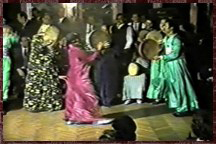 |
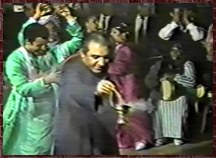 |
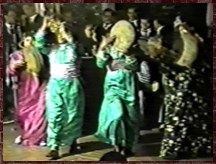 |
I should tell you that in some ways a Zar leader is like a doctor. You listen to the events and you diagnose. A doctor heals the brain, nerves, blood system…etc while the Zar leader is a psychological healer. The Zar brings out the ills inside us. It brings out the depression and anxiety. Every culture has a Zar. In France, in America, in all Arab countries, in Morocco, they all have Zars. But the EgyptianZar is different. The Zar comes in many styles, but the Egyptian Zar is unique. All these beats, such as the samba and the rhumba, come from the Zar beats. When they play this music and dance swaying and bopping their heads, this is a healing process that brings out their ills. But the real Zar is right here.
Sayed: I’d like to hear more from you about the Zar’s movements. The head swaying, how is it done?
Nasser Mohammed Abdallah: In different ways. A woman could do it in a simple way without pattern. Another could go with the rhythm. It doesn’t matter as long as it works.
Sayed: Is the Zar only a healing act or could it be done for entertainment purposes?
Nasser Mohammed Abdallah: Yes, it is held sometimes for entertainment. Others hold a Zar as a yearly experience. It’s a habit for them since they were once healed by the Zar or it could be purely for entertainment.
Sayed: Like a “galabeya” (traditional Arabic gown) party?
Nasser Mohammed Abdallah: Yes, something like that or even a birthday party. Some people chose to hold a Zar and invite their friends and family to sway and dance together.
Sayed: So it would be for fun.
Nasser Mohammed Abdallah: Yes, for fun or, like I said, as an annual event. Or some people who have a spirit problem and have to hold a Zar. They come to us, the Abou al-Gheit band. Like I said, I’ve been working in this profession for 40 years.
Sayed: And how many CDs have you put out so far?
Nasser Mohammed Abdallah: I have made three CDs, all with Sands of Time Music.
Sayed: Do they all have the same rhythms?
Nasser Mohammed Abdallah: No. Each spirit has its own rhythms.
Sayed: Each spirit has 3 or 4 beats. What are they?
Nasser Mohammed Abdallah: For example, there is this one [He demonstrates a beat]. And there’s this one. [He demonstrates two more].
Sayed: Did you inherit this profession from someone?
Nasser Mohammed Abdallah: My paternal aunt was a Zar leader.
Sayed: What about your children? Your oldest daughter is in law school.
Nasser Mohammed Abdallah: Yes, and Ashraf my son worked with famous artists like Samir Sabry and Fifi Abdou and he’s a very good tabla drummer. You know my son Ashraf.
Sayed: Yes, your son took a different direction in music didn’t he? Your children didn’t follow your footsteps in Zar music?
Nasser Mohammed Abdallah: No. This is a hobby.
Sayed: A hobby.
Nasser Mohammed Abdallah: Yes, you have to like this particular profession as a hobby. Yes, my son followed the direction of his uncle and grandfather, who was the leader of the Abou al-Gheit band a long time ago. He was the one who made the tanoura*** famous in Egypt and the Arab world. God rest his soul, his name was Shehata al-Aseel. He toured the world and went to America and other Western countries. He now left this profession.
Sayed: Is this profession becoming extinct?
Nasser Mohammed Abdallah: No, no. This profession is not becoming extinct. But there are fewer musicians than there used to be. Some move on to other styles of music as they become famous. And the Zar today isn’t what it used to be. Years ago, the Zar attendant used to be possessed by spirits and would dance to placate them. He or she would know more about the Zar and would ask specifically for the beat and tools they needed. Now the attendants are more aloof about it.
Sayed: Can you tell me about something comical that could have happened in a Zar once?
Nasser Mohammed Abdallah: One day a man came in. He seemed a little slow and foolish. He walked in as we were playing. He asked us to give him “Salma al-Arabeya”.
Sayed: What’s “Salma al-Arabeya?”
Nasser Mohammed Abdallah: She’s the sister of El Araby (The Arab: Zar 1 – track 6 Salma is mentioned at the end of the song). So I started singing it. He started to gesture with his hands. Like this.
Sayed: How?
Nasser Mohammed Abdallah: Like this. Backwards. Then he started to get tense and didn’t make sense anymore. So my band and I started laughing. I asked him again “What is it that you want?” And he said “Like this” and motioned with his hands again. Then he said “leader of the two camels”. This is another song about an Arab girl who pulls two camels behind her.
Sayed: Could you demonstrate it with the beat?
Nasser Mohammed Abdallah: Yes. [He sings and demonstrates the beat]. “Pulling two camels behind you, where are you going? You pretty Arab girl. Sit down here, close to me, for a little while.” This is the beat for it.
Sayed: Did this work for the man?
Nasser Mohammed Abdallah: No. I was laughing because he just interrupted us and wasn’t happy. He kept gesturing with his hands and I asked him what he wanted. I knew the song he referred to but I couldn’t understand the body movements he was showing me.
Anyway, despite these situations, the Zar is a very real thing. Like I said, there are doctors for bones, for hearts and for nerves. And the Zar leader is a psychological doctor, a spiritual healer. It doesn’t matter how many doctors you go to. If you need a Zar, you won’t heal until you’ve been to a Zar.
The interview was conducted in Cairo during the month of October 2005.
- Arabesque issues: Volume III: #5, #6, Volume IV: #1, #2
- New York Times article: In Cairo, Dance of a Cult Pacifies Demons; To Placate the Genie
By Christopher S. Wren Special to The New York Times. New York, N.Y.: Jul 9, 1979. pg. A4, 1 pg. Text Word Count 1186 - If you are interested in reading further about the Zar please click here.
- The album can be purchased at:
Rashid.com - listed under Religious Music.
(cheapest + free shipping)
The music clips again with author's notes-
- Arabal-Arban30sec.mp3 is referred to several places in the text - in the beginning when he demonstrates three different rhythms for it (it's spelled wrong - Orban and should be changed to say Arban) and at the end where he talks about leading the camels.
- Benatal-Handasa30sec.mp3 is mentioned several times as well. This is the song Shoo Shoo Amin dances to on the video.
- Zar3MoulukalArdiya30sec.mp3 is the bathroom song. It is not on the first album (it's on the third) but he talks about it for a whole paragraph so I thought you might want to illustrate it.
- Aboual-Gheit30sec.mp3 is the group's "theme song". They are named after a Sufi spirit who is considered their 'patron saint'. This is the slowest, most melodic clip of the bunch.
** an animal sacrifice – the ceremony is described fully in the booklet.
***Tanoura is a reference to the wide skirt that Sufi performers wear when they sing praises to God and turn around so that the skirt fills out and whirls around. These performers are called the Whirling Dervishes.


